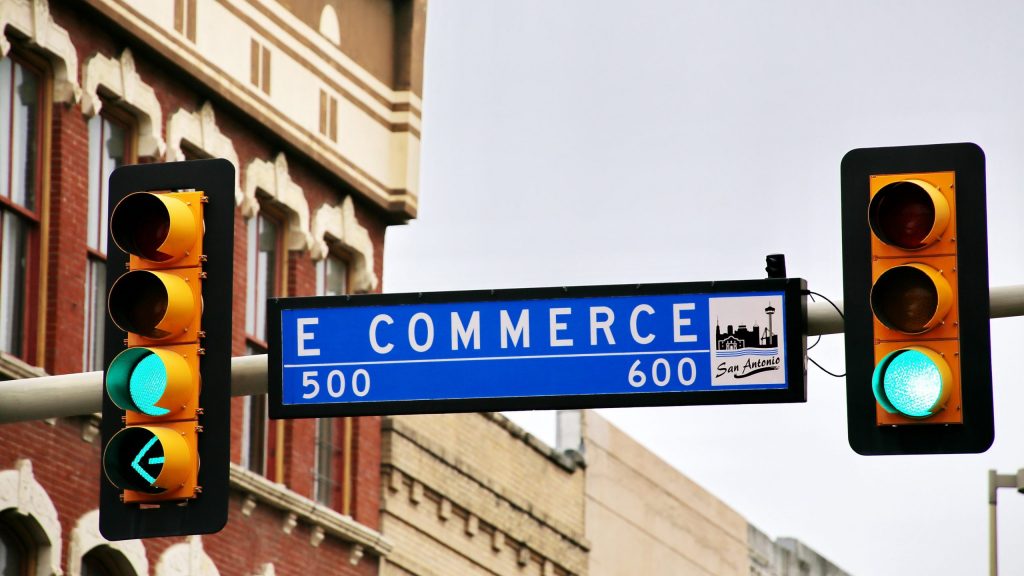The way consumers purchase goods and services has changed significantly over the years. Long gone are the days of busy high streets and packed-out shopping centres. These days it’s the online market place that’s dominating consumer transactions. Many retailers have taken advantage of this trend and have already established themselves in the world of e-commerce, but today we are going to explore the shape of things to come, and how we can best prepare ourselves and our online assets for the future of e-commerce.
 E-commerce is considered to be any transaction that is carried out online, in exchange for goods or services. It refers to marketplaces such as Ebay or Amazon, or can be a brands own website or app. There are two common terms used for defining the different types of e-commerce platforms:
E-commerce is considered to be any transaction that is carried out online, in exchange for goods or services. It refers to marketplaces such as Ebay or Amazon, or can be a brands own website or app. There are two common terms used for defining the different types of e-commerce platforms:
 Year on year, enormous growth has been recorded throughout all platforms of e-commerce. In 2018, consumers globally purchased 2.86 trillion Dollars’ worth of goods online, but by the end of 2021, global e-commerce performance is set to reach 5 trillion Dollars globally. That is an increase in global e-commerce sales of 74.8% over a 3-year period.
78% of companies report that their e-commerce revenues have grown in the past 12 months, and just over a fifth of e-commerce professionals have reported growth of 50% or more in the last year.
Year on year, enormous growth has been recorded throughout all platforms of e-commerce. In 2018, consumers globally purchased 2.86 trillion Dollars’ worth of goods online, but by the end of 2021, global e-commerce performance is set to reach 5 trillion Dollars globally. That is an increase in global e-commerce sales of 74.8% over a 3-year period.
78% of companies report that their e-commerce revenues have grown in the past 12 months, and just over a fifth of e-commerce professionals have reported growth of 50% or more in the last year.
 There are several reasons for the growth in e-commerce, but the single biggest attribution for the shift in behaviours is found to have been the ability to deliver on the customer experience. Econsultancy’s Digital Trends Survey found that optimising the customer experience was a key priority for digital marketers, and e-commerce as the top key priority for retailers.
A study by Hubspot showed that customers are 5 times more likely to recommend a company if they had a good experience, and 93% of customers are likely to make repeat purchases with companies that offer excellent customer service.
There are several reasons for the growth in e-commerce, but the single biggest attribution for the shift in behaviours is found to have been the ability to deliver on the customer experience. Econsultancy’s Digital Trends Survey found that optimising the customer experience was a key priority for digital marketers, and e-commerce as the top key priority for retailers.
A study by Hubspot showed that customers are 5 times more likely to recommend a company if they had a good experience, and 93% of customers are likely to make repeat purchases with companies that offer excellent customer service.
 So with customer experience being at the forefront of e-commerce growth, we should then look at how to capture the positivity people experience, and use their experiences to steer other potential customers towards making a purchase.
A key indicator of whether a product or service has met the needs of its customers is it’s reviews and feedback. We have already discovered that customers are 5 times more likely to recommend a company if they had a good experience, so by capturing that experience and sharing it with others that visit your site, you are not just sharing someone’s view, you are building brand trust.
Research has shown that product pages with at least 1 review experienced a 354% increase in conversion rates, and a 446% lift in revenue per visitor compared to product pages without reviews.
Negative reviews should also always be taken seriously. It is estimated that for every 1 person to make a complaint, at least 7 other people have had the same experience. People with a negative experience are 8 times more likely to share that experience with friends and family over people with a positive experience. Carefully consider the feedback you get from your customers and listen to their struggles.
The take away tip here is to use feedback to guide the development of your e-commerce business and strategies, delivering the experience your customers truly want, and evolving with them.
So with customer experience being at the forefront of e-commerce growth, we should then look at how to capture the positivity people experience, and use their experiences to steer other potential customers towards making a purchase.
A key indicator of whether a product or service has met the needs of its customers is it’s reviews and feedback. We have already discovered that customers are 5 times more likely to recommend a company if they had a good experience, so by capturing that experience and sharing it with others that visit your site, you are not just sharing someone’s view, you are building brand trust.
Research has shown that product pages with at least 1 review experienced a 354% increase in conversion rates, and a 446% lift in revenue per visitor compared to product pages without reviews.
Negative reviews should also always be taken seriously. It is estimated that for every 1 person to make a complaint, at least 7 other people have had the same experience. People with a negative experience are 8 times more likely to share that experience with friends and family over people with a positive experience. Carefully consider the feedback you get from your customers and listen to their struggles.
The take away tip here is to use feedback to guide the development of your e-commerce business and strategies, delivering the experience your customers truly want, and evolving with them.
 Many companies have a pre-defined persona of who their customers are, but they fail to evolve this image over time. Key to delivering on customer experience is having an understanding of the company’s customers and their behaviour as they interact with you.
It is essential to uncover where opportunities are being lost, and why customers are not continuing with a purchase. To do this requires good data insights. Conversions don’t just have to be the point of sale, the customer is taking many steps on their journey to that sale, and each intricate step can be considered a conversion. Learning the points at which most sales are abandoned enable you to develop that aspect of the customers journey, and implement changes to reduce cart abandonment.
Companies can use data to learn their customers’ behavioural patterns and then help guide them towards a sale or conversion.
Many companies have a pre-defined persona of who their customers are, but they fail to evolve this image over time. Key to delivering on customer experience is having an understanding of the company’s customers and their behaviour as they interact with you.
It is essential to uncover where opportunities are being lost, and why customers are not continuing with a purchase. To do this requires good data insights. Conversions don’t just have to be the point of sale, the customer is taking many steps on their journey to that sale, and each intricate step can be considered a conversion. Learning the points at which most sales are abandoned enable you to develop that aspect of the customers journey, and implement changes to reduce cart abandonment.
Companies can use data to learn their customers’ behavioural patterns and then help guide them towards a sale or conversion.
 Things that have previously been considered after services such as speed and choice of delivery, or free and easy returns policies, now act as key decision drivers for customers. As much as 52% of abandoned carts are attributed to the customer not clearly understanding the total costs involved with their purchase until the checkout page, with as many as 87% of these resulting from unexpected shipping costs.
Clearly defined shipping rates advertised throughout the customers journey through the website can prevent the customer experiencing unexpected costs and losing interest in their purchase right before the point of making payment.
Customers too are becoming accustomed to promises of next day delivery, but regardless of the ability to deliver within a time frame, it is imperative that the customer knows how long they can expect to wait for their good to arrive before processing payment.
Things that have previously been considered after services such as speed and choice of delivery, or free and easy returns policies, now act as key decision drivers for customers. As much as 52% of abandoned carts are attributed to the customer not clearly understanding the total costs involved with their purchase until the checkout page, with as many as 87% of these resulting from unexpected shipping costs.
Clearly defined shipping rates advertised throughout the customers journey through the website can prevent the customer experiencing unexpected costs and losing interest in their purchase right before the point of making payment.
Customers too are becoming accustomed to promises of next day delivery, but regardless of the ability to deliver within a time frame, it is imperative that the customer knows how long they can expect to wait for their good to arrive before processing payment.

The Definition Of E-Commerce
 E-commerce is considered to be any transaction that is carried out online, in exchange for goods or services. It refers to marketplaces such as Ebay or Amazon, or can be a brands own website or app. There are two common terms used for defining the different types of e-commerce platforms:
E-commerce is considered to be any transaction that is carried out online, in exchange for goods or services. It refers to marketplaces such as Ebay or Amazon, or can be a brands own website or app. There are two common terms used for defining the different types of e-commerce platforms:
- Business to Consumer (B2C): The most common e-commerce platform where a business sells direct to a consumer. An example may be someone buying themselves a new pair of shoes online.
- Business to Business (B2B): Where a transaction occurs between two businesses. This could refer to a company buying web hosting for their website for example.
E-commerce Rate Of Growth
 Year on year, enormous growth has been recorded throughout all platforms of e-commerce. In 2018, consumers globally purchased 2.86 trillion Dollars’ worth of goods online, but by the end of 2021, global e-commerce performance is set to reach 5 trillion Dollars globally. That is an increase in global e-commerce sales of 74.8% over a 3-year period.
78% of companies report that their e-commerce revenues have grown in the past 12 months, and just over a fifth of e-commerce professionals have reported growth of 50% or more in the last year.
Year on year, enormous growth has been recorded throughout all platforms of e-commerce. In 2018, consumers globally purchased 2.86 trillion Dollars’ worth of goods online, but by the end of 2021, global e-commerce performance is set to reach 5 trillion Dollars globally. That is an increase in global e-commerce sales of 74.8% over a 3-year period.
78% of companies report that their e-commerce revenues have grown in the past 12 months, and just over a fifth of e-commerce professionals have reported growth of 50% or more in the last year.
Customer Experience
 There are several reasons for the growth in e-commerce, but the single biggest attribution for the shift in behaviours is found to have been the ability to deliver on the customer experience. Econsultancy’s Digital Trends Survey found that optimising the customer experience was a key priority for digital marketers, and e-commerce as the top key priority for retailers.
A study by Hubspot showed that customers are 5 times more likely to recommend a company if they had a good experience, and 93% of customers are likely to make repeat purchases with companies that offer excellent customer service.
There are several reasons for the growth in e-commerce, but the single biggest attribution for the shift in behaviours is found to have been the ability to deliver on the customer experience. Econsultancy’s Digital Trends Survey found that optimising the customer experience was a key priority for digital marketers, and e-commerce as the top key priority for retailers.
A study by Hubspot showed that customers are 5 times more likely to recommend a company if they had a good experience, and 93% of customers are likely to make repeat purchases with companies that offer excellent customer service.
Feedback, Ratings and Reviews
 So with customer experience being at the forefront of e-commerce growth, we should then look at how to capture the positivity people experience, and use their experiences to steer other potential customers towards making a purchase.
A key indicator of whether a product or service has met the needs of its customers is it’s reviews and feedback. We have already discovered that customers are 5 times more likely to recommend a company if they had a good experience, so by capturing that experience and sharing it with others that visit your site, you are not just sharing someone’s view, you are building brand trust.
Research has shown that product pages with at least 1 review experienced a 354% increase in conversion rates, and a 446% lift in revenue per visitor compared to product pages without reviews.
Negative reviews should also always be taken seriously. It is estimated that for every 1 person to make a complaint, at least 7 other people have had the same experience. People with a negative experience are 8 times more likely to share that experience with friends and family over people with a positive experience. Carefully consider the feedback you get from your customers and listen to their struggles.
The take away tip here is to use feedback to guide the development of your e-commerce business and strategies, delivering the experience your customers truly want, and evolving with them.
So with customer experience being at the forefront of e-commerce growth, we should then look at how to capture the positivity people experience, and use their experiences to steer other potential customers towards making a purchase.
A key indicator of whether a product or service has met the needs of its customers is it’s reviews and feedback. We have already discovered that customers are 5 times more likely to recommend a company if they had a good experience, so by capturing that experience and sharing it with others that visit your site, you are not just sharing someone’s view, you are building brand trust.
Research has shown that product pages with at least 1 review experienced a 354% increase in conversion rates, and a 446% lift in revenue per visitor compared to product pages without reviews.
Negative reviews should also always be taken seriously. It is estimated that for every 1 person to make a complaint, at least 7 other people have had the same experience. People with a negative experience are 8 times more likely to share that experience with friends and family over people with a positive experience. Carefully consider the feedback you get from your customers and listen to their struggles.
The take away tip here is to use feedback to guide the development of your e-commerce business and strategies, delivering the experience your customers truly want, and evolving with them.
Identifying Customers And Their Behaviour
 Many companies have a pre-defined persona of who their customers are, but they fail to evolve this image over time. Key to delivering on customer experience is having an understanding of the company’s customers and their behaviour as they interact with you.
It is essential to uncover where opportunities are being lost, and why customers are not continuing with a purchase. To do this requires good data insights. Conversions don’t just have to be the point of sale, the customer is taking many steps on their journey to that sale, and each intricate step can be considered a conversion. Learning the points at which most sales are abandoned enable you to develop that aspect of the customers journey, and implement changes to reduce cart abandonment.
Companies can use data to learn their customers’ behavioural patterns and then help guide them towards a sale or conversion.
Many companies have a pre-defined persona of who their customers are, but they fail to evolve this image over time. Key to delivering on customer experience is having an understanding of the company’s customers and their behaviour as they interact with you.
It is essential to uncover where opportunities are being lost, and why customers are not continuing with a purchase. To do this requires good data insights. Conversions don’t just have to be the point of sale, the customer is taking many steps on their journey to that sale, and each intricate step can be considered a conversion. Learning the points at which most sales are abandoned enable you to develop that aspect of the customers journey, and implement changes to reduce cart abandonment.
Companies can use data to learn their customers’ behavioural patterns and then help guide them towards a sale or conversion.
Improving Delivery Options
 Things that have previously been considered after services such as speed and choice of delivery, or free and easy returns policies, now act as key decision drivers for customers. As much as 52% of abandoned carts are attributed to the customer not clearly understanding the total costs involved with their purchase until the checkout page, with as many as 87% of these resulting from unexpected shipping costs.
Clearly defined shipping rates advertised throughout the customers journey through the website can prevent the customer experiencing unexpected costs and losing interest in their purchase right before the point of making payment.
Customers too are becoming accustomed to promises of next day delivery, but regardless of the ability to deliver within a time frame, it is imperative that the customer knows how long they can expect to wait for their good to arrive before processing payment.
Things that have previously been considered after services such as speed and choice of delivery, or free and easy returns policies, now act as key decision drivers for customers. As much as 52% of abandoned carts are attributed to the customer not clearly understanding the total costs involved with their purchase until the checkout page, with as many as 87% of these resulting from unexpected shipping costs.
Clearly defined shipping rates advertised throughout the customers journey through the website can prevent the customer experiencing unexpected costs and losing interest in their purchase right before the point of making payment.
Customers too are becoming accustomed to promises of next day delivery, but regardless of the ability to deliver within a time frame, it is imperative that the customer knows how long they can expect to wait for their good to arrive before processing payment.
Closing Thoughts
Companies are facing new challenges with e-commerce that have never been experienced before in a conventional retail environment. Companies are being forced to get creative with their delivery of service, and must especially focus on delivering an excellent customer experience. Innovation is driving change in the e-commerce landscape, and big companies are testing new methods of delivering their services to their customers, but a seamless experience forged around the needs and wants of your customers will always remain the foundation of success in the e-commerce landscape. Action Analysis works at the forefront in defining, measuring and improving your customer experience. Register for a free consultation today.

